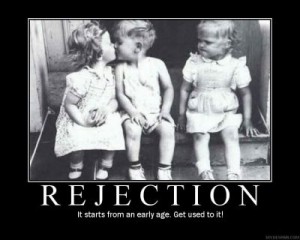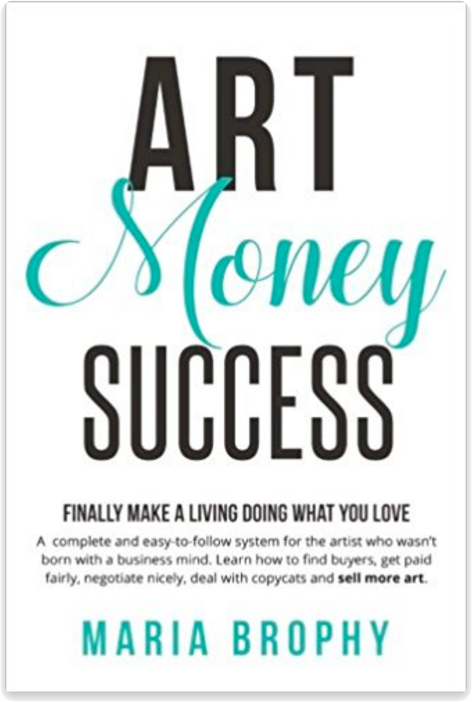 “I take rejection as someone blowing a bugle in my ear to wake me up and get going, rather than retreat.” Sylvester Stallone
“I take rejection as someone blowing a bugle in my ear to wake me up and get going, rather than retreat.” Sylvester Stallone
I received an e-mail from an artist pleading “How do I deal with Rejection? If one more gallery tells me no, I’ll quit being an artist and do something I hate.”
Those of you feeling rejected: you are looking at this all wrong. People are not rejecting you. It’s not about you or your art at all. It’s about them.
Stop what you’re doing right now and change the channel in your mind. Rejection doesn’t exist in the sense that you think it does. If you can change the way you SEE being told “no” than you can cope with it and even thrive from it.
REJECTION IS AN ILLUSION. IT’S ALL IN YOUR HEAD.
Remove the word “rejection” from your vocabulary and replace it with “deferred.” Deferred has a much better sound to it, doesn’t it? It means that you are being postponed, delayed, temporarily put off.
You told your mother, “I went into a gallery and was deferred.”
“Oh? What do you mean?” She asked, curious.
“They said they weren’t interested. So I’ll defer my approach with them for now and look for other opportunities.”
Every NO is temporary. The NO turns into a YES when the timing is right. It’s up to you to still be there when that happens.
Being deferred (formerly known as “rejection”) is not personal. The person telling you “no” just doesn’t need what you are offering at that time. It DOES NOT mean that your art isn’t good. The best of the best of the best in this world get denied.
Sometimes, the people you approach just have too much to choose from. They aren’t ready for you yet.
Often, people just don’t GET what it is you do or what you’re about. Most people are not visionaries, so you can’t blame them if they don’t recognize your ideas or your art as the next earth shattering thing.
The Beatles were turned down by nearly every record label in Europe before landing a record contract with EMI in 1962. Everyone said they wouldn’t make it.
J.K. Rowlings, author of the wildly popular Harry Potter series, was turned down by more than a dozen publishers before she got the first book published. (You know they are all kicking themselves now!)
It’s painful to be told that your art or your manuscript isn’t wanted. The word “no” cuts like a knife right into your healthy psyche. Chews you up and spits you out. Makes you feel less worthy. Bitter.
But, what if we are misinterpreting rejection? What if being rejected is just an ILLUSION. It doesn’t really exist. Just like good and bad in the practice of Buddhism, rejection exists only in your untamed mind.
Our minds make up all sorts of nonsense that we seem to have little control over. If we let it run loose, our creative brains will make up crazy stories about evil people who have done us wrong by telling us “no” and how they ruined our careers and how they are hateful and blah blah blah. It can get out of control if we let it. I blame that untamed mind-monster on being human.
Creative people can practice how to tame the mind-monster by learning from others. Here are some of the lessons I’ve taken away from other professions:
IT TAKES MANY NO’S TO GET A YES: In the life insurance world of cold calling sales, insurance salesmen know that for every 9 hang-ups and “no thank you’s”, they will get that one golden “yes.” The most wealthy insurance salespeople are the ones that don’t take “no” personally. They see each NO as a pathway to the one person who will sign on the dotted line.
NO DOESN’T MEAN NO; IT JUST MEANS NO FOR NOW: Many years ago we approached Wham O’ to license Drew’s art for their boogie boards. They said no. A year later we tried again. They said no. The third year they finally said “yes.” It was the right timing for them. Thank goodness we didn’t give up after two tries. I learned a valuable lesson from that – don’t give up. Keep following up. “No” only means no for right now, no matter what they tell you.
TAKE A “NO” AND ASK “WHAT CAN I DO BETTER”? When someone turns you down, instead of putting your head down and crying on the walk to your car, stand up straight and ask “do you have any suggestions on what I could do to make this work for you? What changes could I make, if not for you, than for the next person I approach with this?” Some people will be helpful and give you suggestions on what changes you need to make, if any.
COUNT EVERY REJECTION AS A NOTCH ON YOUR BELT: Writers know that every rejection letter that they receive gets them closer to a book deal with a publisher who will say “yes.” Some writers look forward to their “no” letters. It’s a rite of passage for them. (Check out 30 FAMOUS AUTHORS WHOSE WORKS WERE REJECTED REPEATEDLY)
NURTURE RELATIONSHIPS: When you are told no, accept it graciously and thank them for their time. Do not get angry. Maintain a good relationship with people. Like our Wham O contact who turned us down year after year; we kept in friendly contact and eventually we got the deal.
KEEP DOING WHAT YOU’RE GOOD AT: Tim Burton, the hugely successful film director, producer and artist has had more of his films rejected by studios than accepted. He will work an entire year on a film, only to be told that it won’t be produced. Does he quit? No, he moves onto the next project and starts working again. He accepts this as part of the process and it has never stopped him from plugging along.
 SOMETIMES A “NO” IS A GOOD THING – IT OPENS OTHER DOORS: Three years ago I produced a DVD called “Paint Pen Techniques with Drew Brophy”. Looking for sponsors, I approached the shoe company Vans to have Drew paint their shoes in the video in exchange for sponsor dollars.
SOMETIMES A “NO” IS A GOOD THING – IT OPENS OTHER DOORS: Three years ago I produced a DVD called “Paint Pen Techniques with Drew Brophy”. Looking for sponsors, I approached the shoe company Vans to have Drew paint their shoes in the video in exchange for sponsor dollars.
They said NO! I was so disappointed, and deflated I thought for sure they’d think it was a great idea. Then we asked Converse, a company that’s about 8 times larger than Vans, and to my happy surprise, they said YES. The beautiful thing is that it led to an even better opportunity – a licensing deal for Drew Brophy Chuck Taylor Collection. A disappointing NO turned into a wonderful deal with a larger company.
REALIZE THAT YOU DON’T FIT IN EVERYWHERE / FIND YOUR OWN PEOPLE: One thing I’ve had trouble with at times is not being accepted into certain groups. Once we were told that Drew wasn’t “hip” enough to be a part of an art show that had a lot of “hip” artists in attendance! That hurt, ouch, but it helped me to understand that our persona is not going to be a match with everyone. We have our people, and they love us. And the other people, well, they have their own thing that we just don’t fit with. And that’s okay. We all have to find the people that get us, that understand what we are doing, and that appreciate it.
You are worthy, your creations are worthy, and there are many opportunities just lining up to accept you and your art right now. Don’t give up when you’re deferred with the word “no.” Remind yourself that sometimes it takes quite a few to get to a yes.
“A rejection is nothing more than a necessary step in the pursuit of success.” Bo Bennett
PS: Artist Joanne Mattera wrote an excellent post on dealing with rejection. Here’s her post titled REJECTION, DEAL WITH IT!
Maria xxoo















31 Responses
I’ve been so far ahead of the power curve that when the wave finally breaks, I’m caught inside. Bummah.
Getting “deferred” is also a great way to spend more time with your current people. Nurturing who I have as well as nurturing a potential future relationship.
Thanks for this, an excellent reminder not to take things too seriously.
Many thanks Maria, for such a wonderful and inspiring post about rejection- oh, I mean deferment . That ‘NO’ is one of the hardest parts of life to deal with, especially when it happens over and over again. But, as you pointed out, it’s all in how we perceive the NO and whether we will beat it back or let it rule us. Like you mentioned in another post, it’s time to decide if you’re the sheep or the wolf and the wolves are the ones that succeed no matter how may NOs they get.
Maria–Enjoyed this article. Profound stuff on many levels. I don’t know how many hundreds of submissions I’ve dropped into mail slots going out to literary journals and magazines, and lots of my poetry has been published too. But of course there were rejections. For every one rejection I’d send out ten more manuscripts. The more I sent out the more acceptances I would get. Receiving both is all part of the process. The experiences of receiving acceptances and rejections for my creative writing has made it easier to understand the submissions process in relation to my visual art. If you are *not* getting rejections then you are *not* stretching and putting yourself out there enough– probably only going after the safe sure bet stuff.
Thanks Maria. Perfect post for these times too. It’s been tough. When people and companies are scared to spend money it is so easy for them to say no more quickly. They practically don’t even want to hear any options or alternatives that an artist can provide for solutions to what they need. Even though it is expected in times like this it is hard not to feel rejected when we are trying to maneuver around this slump and grow. Thanks for the inspiration! I always love reading your posts!
Thank you Maria. You bring up some good points here. You’ve always managed to put a positive spin on what could otherwise be looked at as a negative.
That covers the ‘no’s’, ‘rejections’, ‘deferments’. At least with a no answer you’re getting some form of feedback. Now, what’s the best way to handle being ‘completely ignored’, the ‘not even worthy of a no’ response?
Great post, and a great reminder. I have a folder full of rejection letters in my filing cabinet. They are like battle scars, reminding me that I am actually out there and making things happen, not just sitting at home waiting for my dreams to come to me.
Thanks everyone for all your comments!
Annie, you asked what to do when you are “completely ignored”?
Yes, being ignored is so frustrating! It’s a serious pet peeve of mine. But here’s how you handle it: The same way. Don’t take it personally (there could be a million reasons the person isn’t responding). Handle it with grace and continue reaching out every now and again.
I can’t even tell you how many times I’ve heard I’m not “edgy” enough. I can’t help it! Even when I’ve tried drawing skulls and other “edgy” things, they end up cute and pretty. I agree that sometimes it’s just not the right fit. Plenty of people like cute and pretty art. I just gotta hang with my people!
Oops… Maria, Boss, don’t use cuss words…that would be so unladylike of you…but I admit it…I have been out of the loop for sometime now, busy hibernating under a tree like a bear and gazing at the shapes of clouds…after all, poets will be poets…dreamers.
Then again, what else can you expect from a guy like me, right?
Nice post, once again, by the way. Liked it very much, as usual.
It sounds like the story of my life. I have had quite a few publications to my name too, but there is a pile of rejection slips from irate editors/publishers that could make a grown man weep, but not me.
I took it in my stride. I also threw those rejection slips away. Such clutter. Ah, life is a journey. Why focus on the destination?
And, yes, it is a joy to be back. I am thankful to the guiding light which enabled me to find your blog. It has been a pleasure to read your work. Best wishes to you and your lovely family. May the road you walk on be paved with gold and honey. Hang in there, old friend. Cheers!
Archan, YOU”RE BACK! Yah! I was missing you. Thanks for visiting my blog, and of course, for your insightful comments (as always).
Don’t ever leave me again. I don’t think I can handle the rejection….
Ah, Maria, just to clarify, old sport:
Take heart in knowing I would never leave you, but I do have eyes for other blogs as well. I have a tendency to wander and explore. Sorry!
I would never reject you, but even if I stray from the straight and narrow, you know that ultimately I will return to your blog.
And every time I am with other blogs, rest assured that, like James Bond, I am only doing this for Queen and country.
Yours is the only blog in my life, Moneypenny….oops…I mean, Maria!
I understand, 007, I mean, Archan!
Yes, yes, yes! Lovely outlook and thoughts. . Thanks for sharing!
Maria, you’ve hit the nail on the head once again! I used to internalize “rejection” of my work, and over the years I’ve come to the realization that it’s not “me”, the work is a “product” to the client. As an artist or musician or writer, it is so difficult to separate “self” from “work product”.
Trying to stay positive, I don’t have a “rejected job quotes” file on my computer, I have a “holding tank”! I agree that it is important to nurture the relationships with your business contacts, especially when they put the job “on hold”! I’ve had many of those decide to do business with me in the future – OR they’ve referred a NEW client to me for artwork!
Thanks again for your great posts!
Dawn, I love the “Holding Tank” file. That’s awesome! Everyone should have one.
Hi. I”m an artist and I liked your post so hope you don”t mind ”cause I’ve writed about you on my blog . http://blog.goldmidas.eu/?p=806
I ‘m an artist and I have a most unusual situation at the moment. I learned of the Kickstarter site and applied and my project was accepted. It all happened very fast. So now, with little preparation or forethought I have a limited time to find sponsors in varying amounts beginning at $1. toward a total goal.
While I have lots of experience submitting my creative work and have received more acceptances than rejection so that I do not have issues there. I do have serious problem asking for and getting money– so I hope this project will break down some walls for me in that way. For now I am contacting people about this project and finding tactful ways to enlist their support. I have received now rejection yet but I have asked so few so far–and that is how fear of rejection can limit one.
Marie, I would suggest that when asking people to contribute, let them know what good it is doing so that they feel great about the contribution.
If their donation is helping to further art in some way, they are going to be more interested in doing it. Take the emphasis off of YOU and place it on THEM – it will be much easier to ask for donations when it’s coming from a place of what THEY will get from it.
And when you take the emphasis off of YOU, it’s easier to ask! (Because now you aren’t focusing on yourself, but on them instead.)
Thanks Maria
I am getting lots of support from people who are posting my Kickstarter project to their blogs and sending it out in their newsletters. So getting other people to ask for me is a plus I had not even considered when I started the project. A lot of very interesting connections and communications have occurred in just the first few days after the project went live.
I am posting updates on my blog(s)
Timely reading and very well put. Thanks for taking the time – and continuing success to you and your husband!
Euphrosene
a good blog article ,We stock Argyle, Bailey, Cardy, Sheepskin, … ugg boots.
Very good.
This post hit me just right. Now I am standing straight and can
see much more clearly.
There are so many positive ways to view “no” it makes no sense to let it upset your drive and optimism to contribute and be happy with what life has in store for us.
Thank you so much for this. It changed the way I look at everything.
Thank you Maria for this WONDERFUL essay about rejection!!!! It is very helpful .
Thank you thank you thank you -what a great viewpoint on never giving up on your dreams!
I did not enjoy. I disagree with your views
I know this article was in 2010 but I Googled art rejection today and this truly spoke to me. I’m just frustrated. What I hate most about the rejections, is when the companies tell you to get familiar with their lines of work. The stinger is when they say they require high quality, detailed art…But that’s not what you find on their website. 30% is high quality but the other 70% is not. I’ve literally seen greeting card companies proudly push images of poop. People and animals are drawn as sticks. They preach one thing then carry the complete opposite. It’s like their brands start following some of these trends where the art is literally just blobs thrown together or they just push whomever has a popular Instagram account. Yes, it’s their business but atleast be honest when writing out the artist submission guidelines.